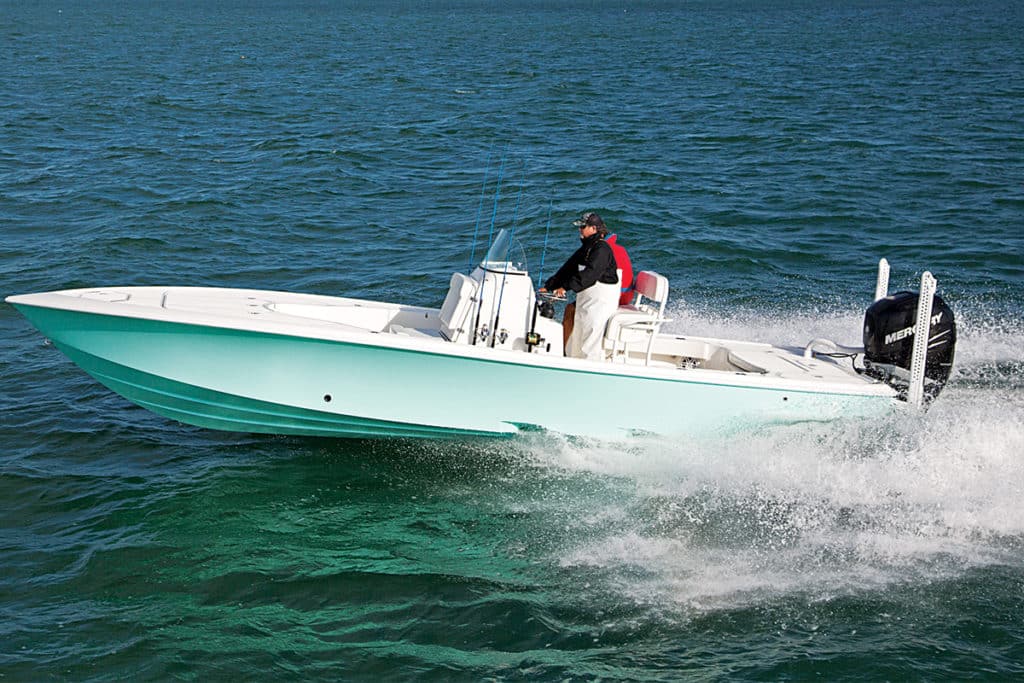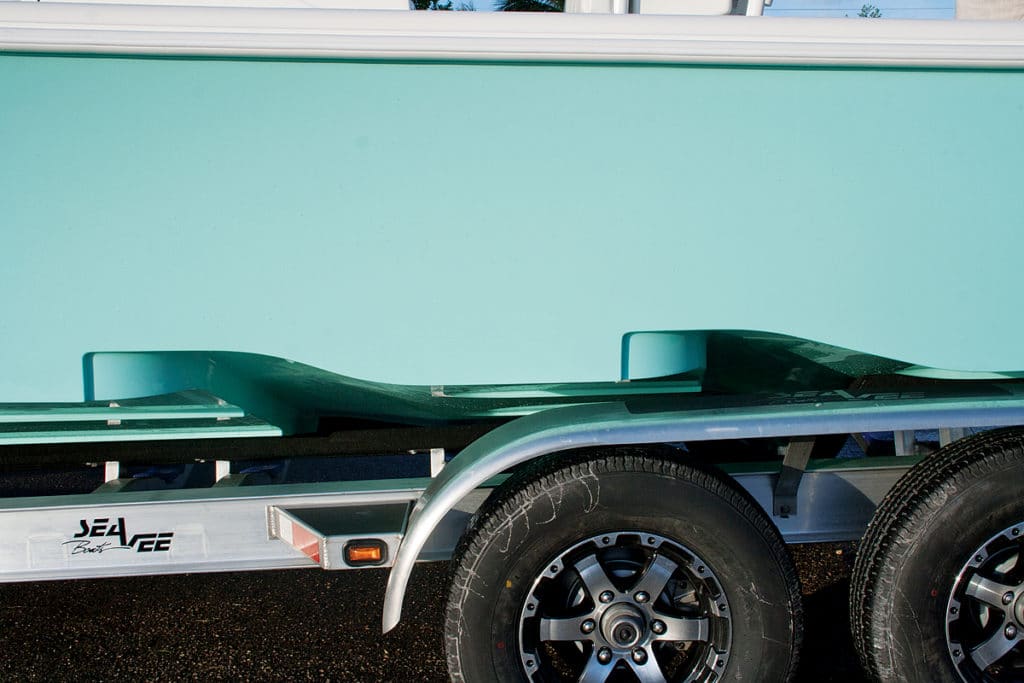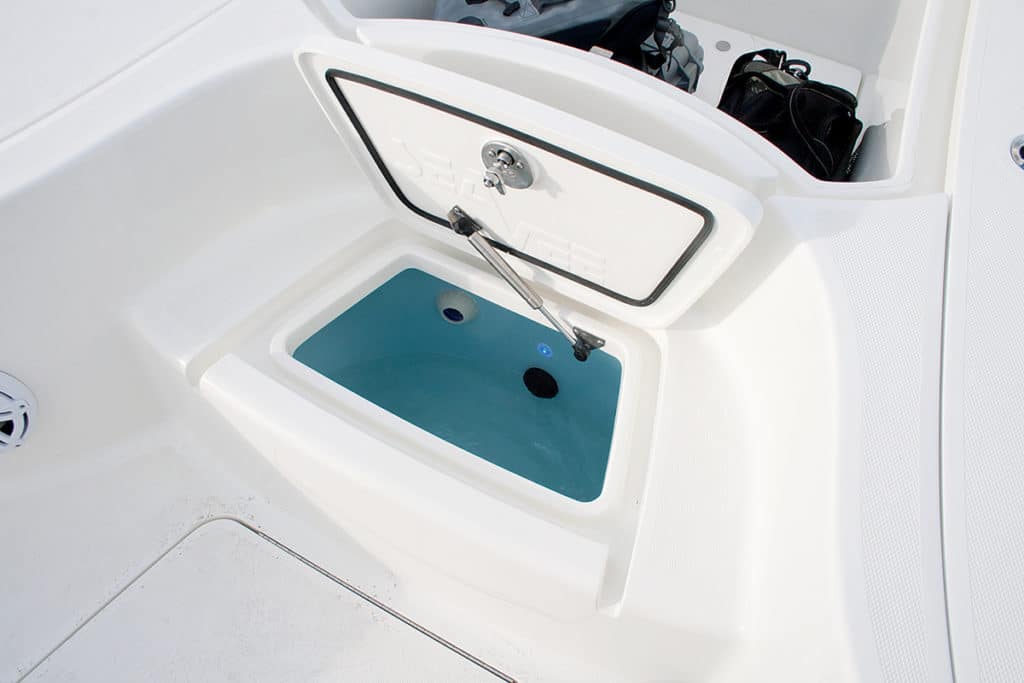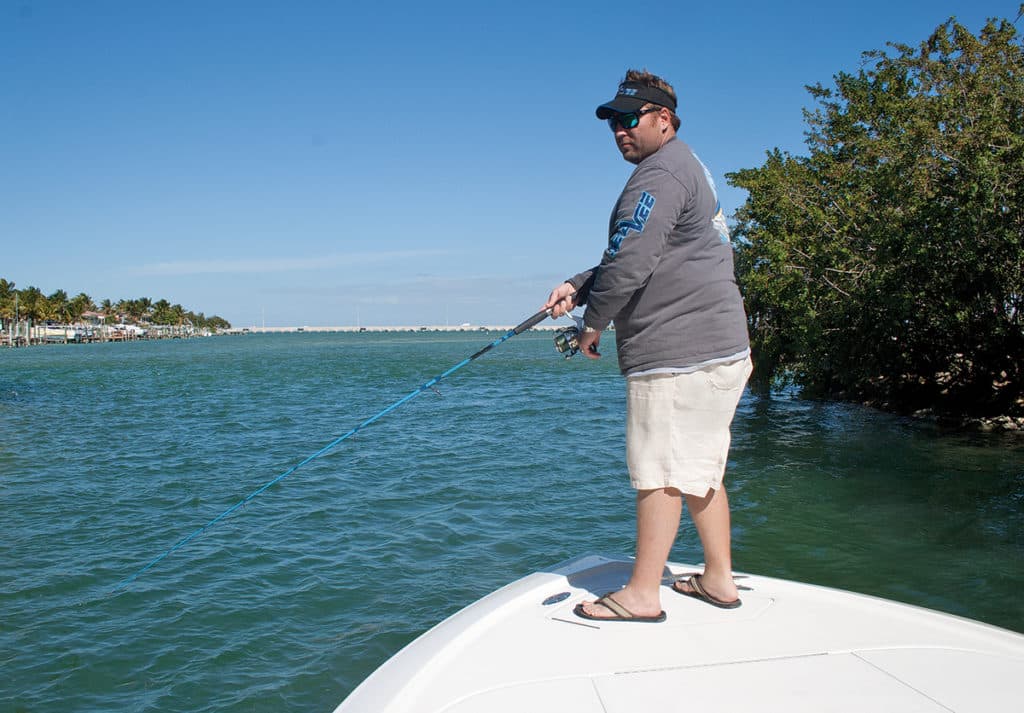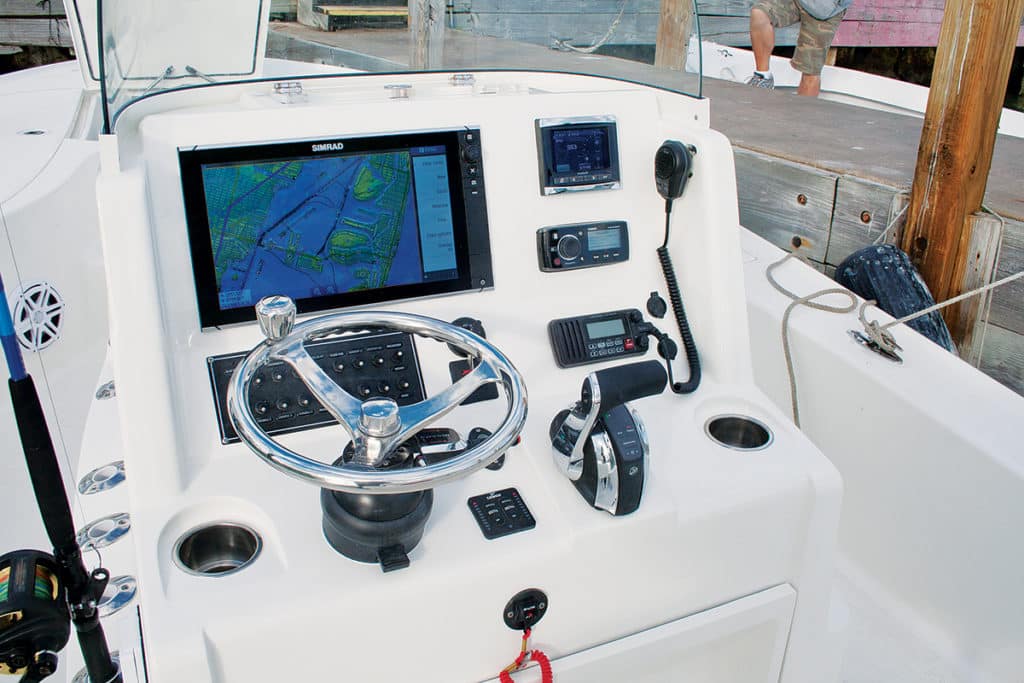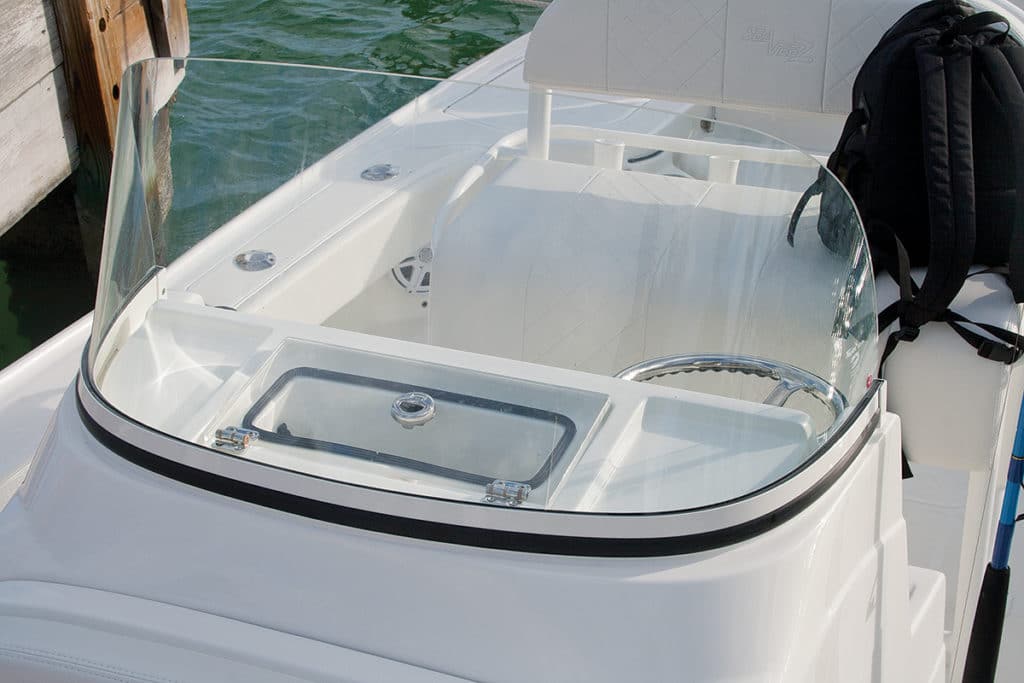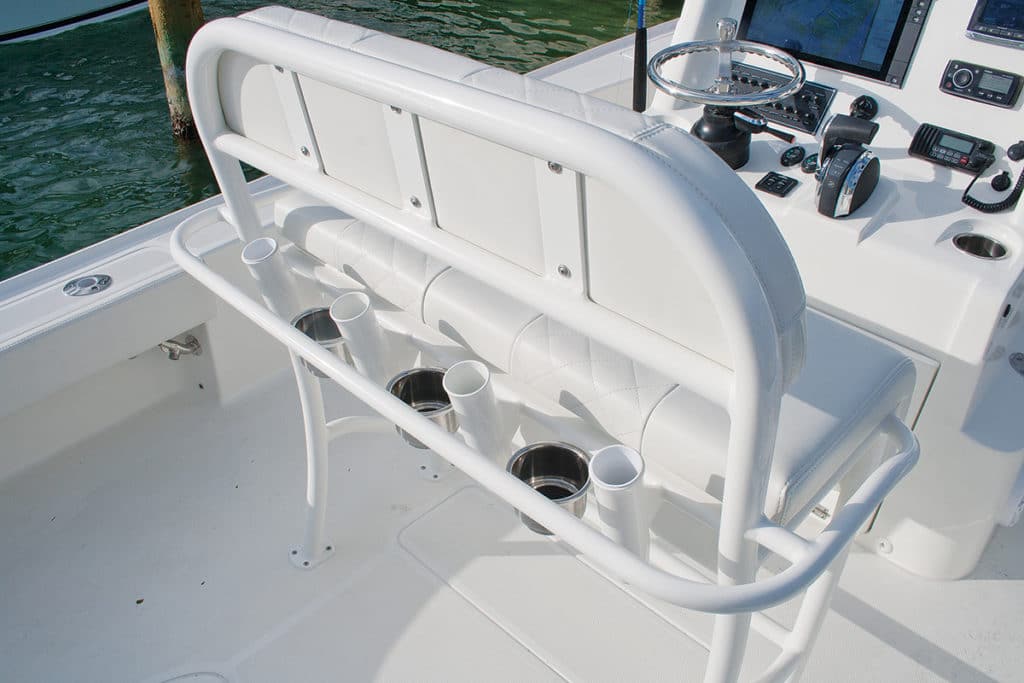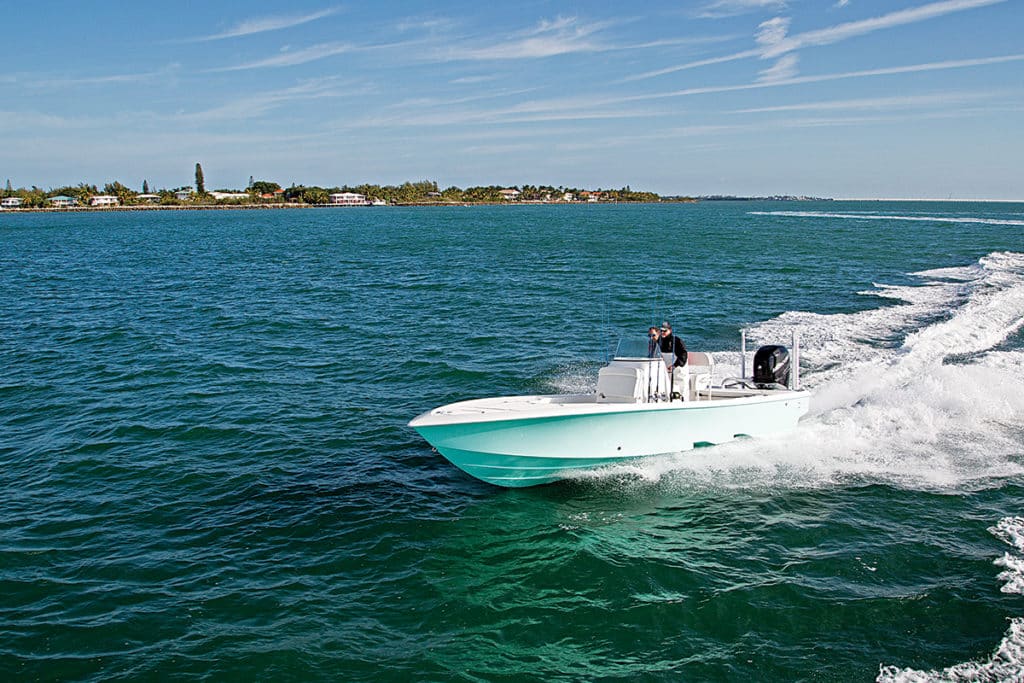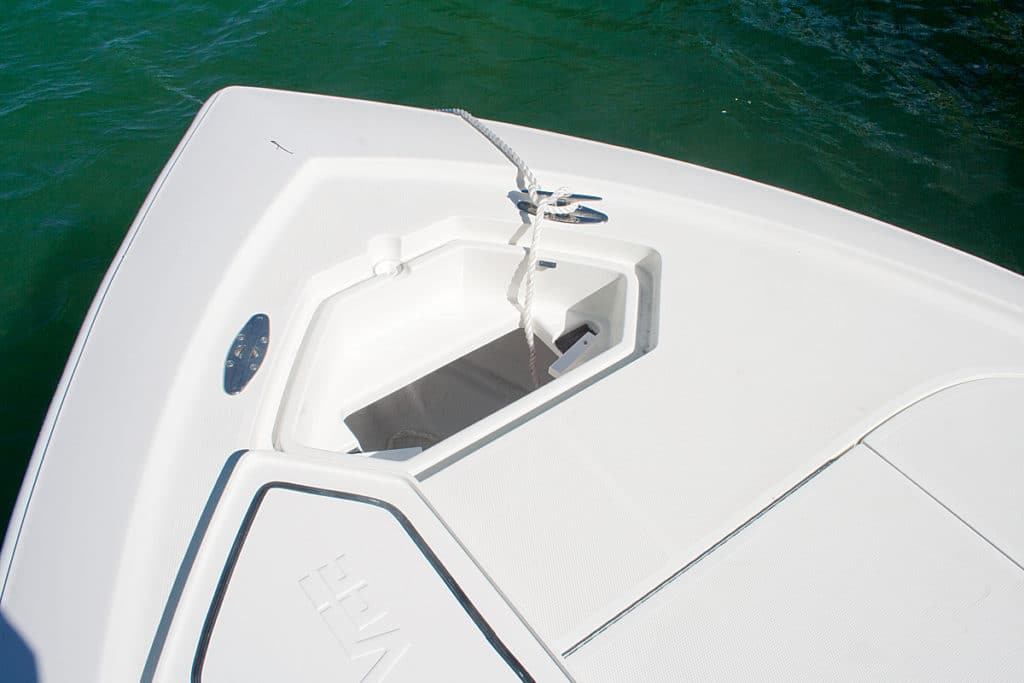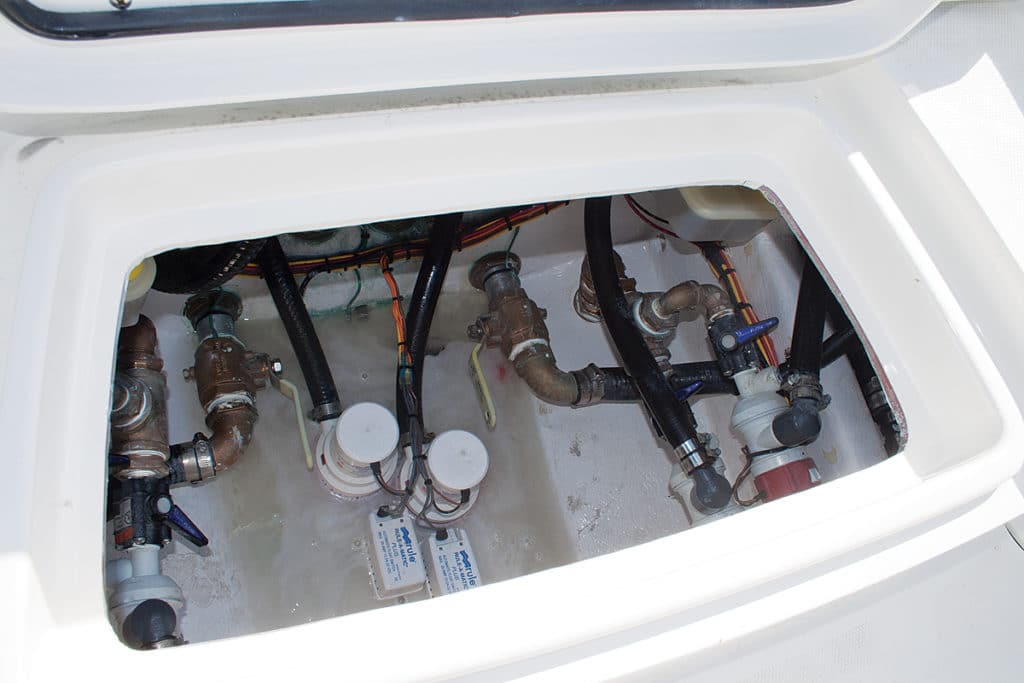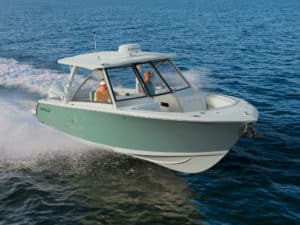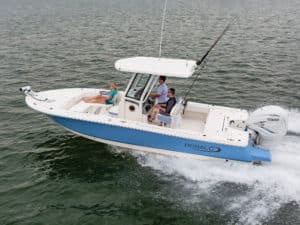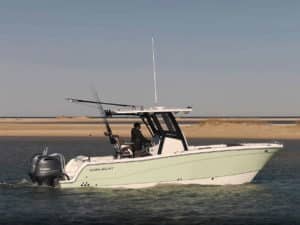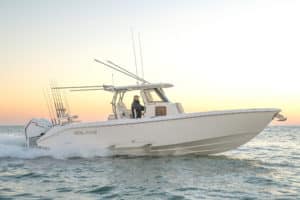If you haven’t noticed, bay boats are getting bigger lately, and the latest to emerge is the biggest yet: the SeaVee 270Z Bay. This boat, however, boasts more than size. It reflects a sophisticated running surface, intricate design details, state-of-the-art construction and sleek, sexy lines.
Interestingly, this is also the smallest model in SeaVee’s current stable of fishing boats, which ranges upward to 43 feet.
Yet, how does the new bay boat fish? To find out, I joined Robert Kaidy, naval architect and SeaVee vice president of engineering; Jason Scruggs, SeaVee production manager; Capt. Greg Poland; and Scott Salyers, group publisher for Sport Fishing, for a day of fishing off Florida’s Duck Key.
With a 27-foot length overall and a 9-foot-1-inch beam, the 270Z offered plenty of room for five anglers and remarkable lateral stability as four adult males stood along the starboard side while loading gear and bait at the dock. The 270Z barely listed with more than 750 pounds on the gunwale.
Uplifting Experience
To see how this bay boat handles on open water, Poland put us on a course toward the patch reefs on the Atlantic side of the Keys amid 20- to 25-knot winds that had blown all night, leaving the waters scalloped with whitecapping 3-footers.
About a mile outside the harbor, I asked for a turn at the wheel. Poland brought the 270Z back to idle, told me what course to steer, and relinquished the helm. I punched the throttle from a standing start and could feel the boat lift as speed steadily increased. Riding high, the 270Z easily bridged the wave tops.
With the single 300 hp Mercury Verado pegged at wide-open throttle in the rough conditions, I had expected a white-knuckle experience but was pleased to discover a soft yet exhilarating ride, thanks to the cross-ventilated twin-step hull that creates a cushion of air under the running surface.
“The 270Z actually features multiple lifting bodies with a unique geometry that results in a fixed running-trim angle,” Kaidy explains. The hull incorporates a central air-reservoir unit that produces and maintains the necessary air cavities to reduce drag at a wide range of speeds, according to the engineer.
Throttle jockeys will love it, but I eventually backed off to the midrange on the run to maximize the fuel efficiency of the Z, which comes with a 100-gallon tank. I found a sweet spot at around 38 mph. The hull easily maintained its lift at speeds as low as 16 mph.
We took a detour when Poland spotted a flock of terns working over a school of Spanish mackerel, abruptly changing course to intercept the action. This is where the sound engineering of a stepped hull really shines. Poor designs have a nasty habit of catching the edge of a chine and swapping ends during high-speed turns.
Yet hard-over maneuvers with the 270Z proved smooth and predictable, as if executed on rails. Credit the patent-pending SeaVee design that produces opposing concentrated pressure on the hull’s speed rails to keep the boat tracking on the desired path.
Relative to other big bays boats, the 270Z possesses a relatively high prow. This lends the boat its sweeping sheer line and flaring bow that helps knock down spray, but it also creates more windage than you might expect with a bay boat.
Wide-Open Spaces
As Poland positioned us upwind from the school, three anglers grabbed rods and stepped up on the bow platform to make casts to the fish. While the platform sits 20.5 inches above the main deck, a central step, which also serves as the hatch for the 24-gallon pressurized forward livewell, makes it easy to get up and down. When the livewell is open, as it was much of the time while we fished, you’ll still find steps at each side of the opening.
Measuring 92 inches wide and 78 inches along the centerline, the bow platform is among the biggest I’ve seen. There’s also lots of deck room on the aft casting platform, which measures 98 inches wide and 42 inches along the centerline. SeaVee maximized the space by eliminating the splashwell; instead the outboard mounts on a hydraulic jack plate from SeaStar Solutions. One-inch toe kicks around the exterior edges of the decks and covering boards offer a measure of safety.
As we drifted in the 3-foot seas, I marveled over the at-rest stability. Even in a beam sea, I easily maintained my balance. Diamond nonskid throughout assures traction.
The Spanish mackerel turned up their noses. And so we continued our run toward the patch reefs. The 270Z Bay offers several places to perch while underway, including two on the helm leaning post, which has a backrest and storage under the seat.
Two other crew members can stand behind the leaning post, which offers a convenient anodized-aluminum grab rail along the aft edge, and space to secure a Frigid Rigid cooler underneath. A jump seat with a backrest that lifts up from the aft casting platform provides a place for two crew to take a load off, and there’s a comfy seat forward of the center console with a 17-gallon cooler below.
The solid feel in rough conditions gave me a sense of the construction that underpins the 270Z. The hull and deck are completely infused with stringers and bulkheads in a process called vacuum-assisted resin-transfer infusion. This cored unibody construction results in a boat that is practically indestructible. Foam flotation renders it unsinkable.
Command Center
As we closed on the patch reefs, Capt. Poland used the flush-mount Simrad NSS16 evo2 chart plotter/sonar to locate a productive area. The 31-inch helm panel also had a flush-mounted Icom M412 VHF radio and a Mercury Vessel View display.
Atop the console I found a wraparound tempered-glass windshield, and a convenient, watertight glove box for stashing items like mobile phones. Fiddled trays on either side are great for stowing tubes of sunscreen and sunglasses.
Though my test boat had no top, based on experiences in the boating market, Kaidy believes that most buyers will order the 270Z with a hardtop, which allows anglers to mount antennas and radar domes up high. It’s important to note that every SeaVee model is built to order, allowing buyers to customize their boats to specific desires and needs.
With the strong breeze, Poland decided to anchor, which gave me a chance to check out how well the anchor locker worked. One of the first things I noticed was that the hatch, which opens to port, lays flat on the deck in the open position. “I can’t tell you how important that is,” says Poland. “It keeps the hatch out of the way while you deploy or retrieve the anchor.
“With hatches that remain partially open, there’s the distinct possibility of leaning against them and breaking the hinges, especially in rough conditions,” he adds. “With a hatch that rests flat against the deck, you don’t have to worry about that.”
The hatch — like all 17 hatches found on the 270Z — is resin transfer molded and features a glossy gelcoated backside embossed with the SeaVee logo. The locker itself is cavernous and easily handles 300 feet of anchor line. Special latches secure the anchor crossbars, and pullup cleats on both sides of the locker let you quickly tie off the line.
**
Shallow Thinking**
Once again, however, the fish refused to bite, and so we headed back in to fish the shallows outside the jetty protecting Hawks Cay Resort, where we had launched the boat. The approach to the spot took us over a flat, where I was able to judge the shallow-water abilities of the 270Z Bay, which draws just 15 inches of water. With the engine hiked up using the jack plate, we easily motored across the flat, which had a 2-foot depth at the time.
You can also run an electric -trolling motor off the bow using an optional molded fiberglass piece with a pad for the motor bracket. Three 31-series batteries for the trolling motor install under a removable floor in the huge, 107-gallon central stowage locker in the foredeck.
Poland deployed the twin Power Poles on the transom to anchor the boat in position to fish the jetty, and as the crew fished live shrimp along the edge, I explored the interior features a bit more.
Additional hatches in the foredeck include a pair of 75-gallon insulated, overboard-draining fish boxes. Abaft each are lockable rod lockers that can each stow four sticks up to 9 feet in length. You can fold away the rod racks and use these two lockers for general stowage too.
An in-sole locker forward of the console features a molded recess for securing a five-gallon bucket with a cast net, as well as stowage space for safety gear surrounding the pail. Access to the fully gelcoated console interior, including hatches for the helm rigging, the battery switch, main breaker and distribution panel, is via a forward hatch that also serves as the backrest for the console seat.
Along the sides of the console I found convenient vertical stowage for six rods to port and four rods to starboard. Walkways along the sides of the console measure 18 inches wide, making it easy to fight a fish along the rail.
A pressurized 30-gallon livewell lies under the aft casting platform, flanked by a pair of 17-gallon release wells — which can double as livewells or fish boxes — in the aft quarters. An in-sole hatch just behind the leaning post offers access to the immaculate bilge rigging.
Return Visit
Unfortunately we fared no better inshore than on the patch reefs, so we called it day, but I wasn’t done with the 270Z. Two weeks later I climbed aboard again to collect performance data in waters off Miami Beach, but now running the new Mercury 350 Verado outboard and a Merc Enertia Eco 16-by-19-inch three-blade stainless-steel propeller.
With two adult males and 40 -gallons of fuel on board, the 270Z vaulted from 0 to 30 mph in 9.5 seconds en route to a top speed of 57.3 mph at 6,000 rpm, where the 350 hp in-line-six engine burned 30.8 gallons per hour for 1.86 mpg.
The most economical cruising speed came at 4,000 and 36.4 mph, with the big Verado burning 11.6 gallons per hour for an impressive 3.14 mpg. I also retested for the minimum planing speed, which occurred at 15.5 mph and 3,200 rpm with the new motor.
The 270Z is available with twin outboards, but given the kind of performance I recorded with a single 350 and the inshore nature of this boat, I would have a hard time justifying the extra power.
Finally, one of the most surprising aspects of the 270Z Bay is the cost. I had braced myself for a high number but smiled when I heard a base of just over $104,000. That represents an outstanding value, especially when you consider the SeaVee name, advanced hull, rock-solid construction, and exemplary fit and finish of this, the world’s largest bay boat.
